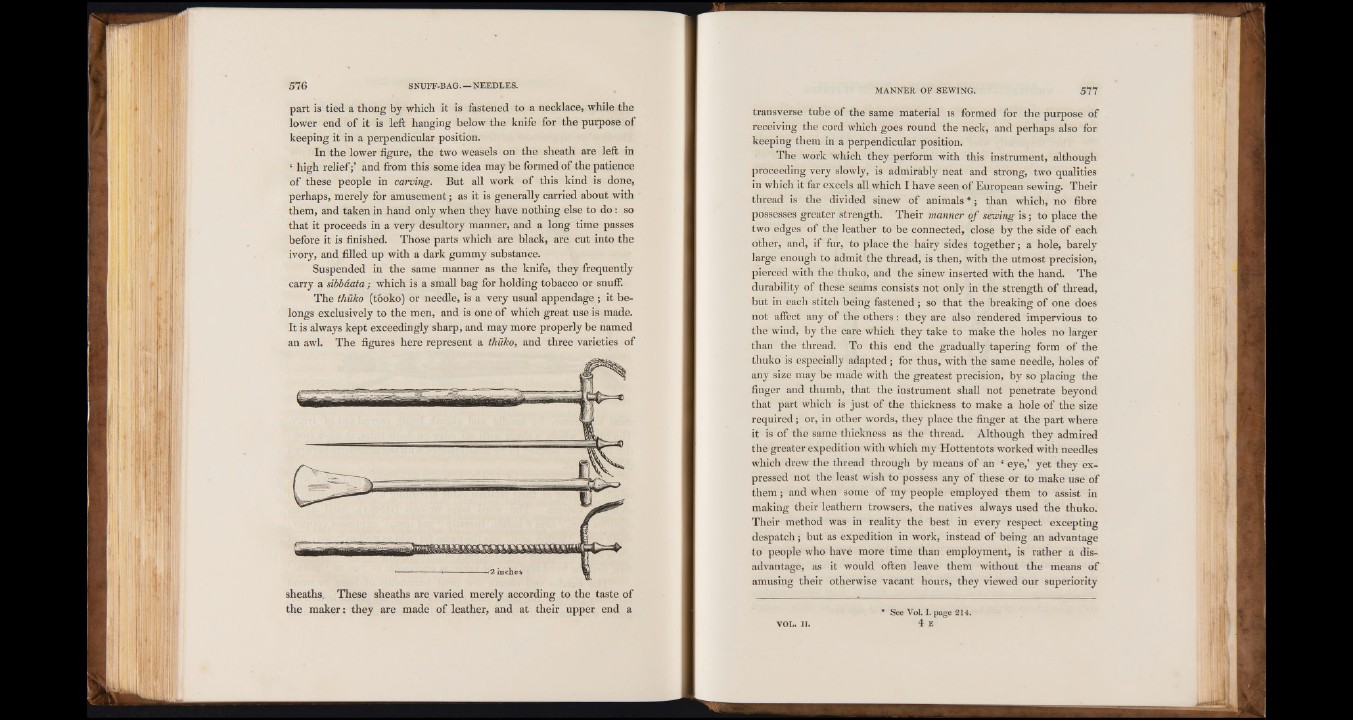
5 76 SNUFF-BAG.—NEEDLES.
part is tied a thong by which it is fastened to a necklace, while the
lower end of it is left hanging below the knife for the purpose of
keeping it in a perpendicular position.
In the lower figure, the two weasels on the sheath are left in
* high re liefa n d from this some idea may be formed of the patience
of these people in carving. But all work of this kind is done,
perhaps, merely for amusement; as it is generally carried about with
them, and taken in hand only when they have nothing else to do : so
that it proceeds in a very desultory manner, and a long time passes
before it is finished. Those parts which are black, are cut into the
ivory, and filled up with a dark gummy substance.
Suspended in the same manner as the knife, they frequently
carry a sibbaata; which is a small bag for holding tobacco or snuff.
The thuko (tooko) or needle, is a very usual appendage ; it belongs
exclusively to the men, and is one of which great use is made.
It is always kept exceedingly sharp, and may more properly be named
an awl. The figures here represent a thuko, and three varieties of
sheaths. These sheaths are varied merely according to the taste of
the maker: they are made of leather, and at their upper end a
transverse tube of the same material is formed for the purpose of
receiving the cord which goes round the neck, and perhaps also for
keeping them in a perpendicular position.
The work which they perform with this instrument, although
proceeding very slowly, is admirably neat and strong, two qualities
in which it far excels all which I have seen of European sewing. Their
thread is the divided sinew of animals *; than which, no fibre
possesses greater strength. Their manner of sewing is; to place the
two edges of the leather to be connected, close by the side of each
other, and, if fur, to place the hairy sides together; a hole, barely
large enough to admit the thread, is then, with the utmost precision,
pierced with the thuko, and the sinew inserted with the hand. The
durability of these seams consists not only in the strength of thread,
but in each stitch being fastened ; so that the breaking of one does
not affect any of the others: they are also rendered impervious to
the wind, by the care which they take to make the holes no larger
than the thread. To this end the gradually tapering form of the
thuko is especially adapted; for thus, with the same needle, holes of
any size may be made with the greatest precision, by so placing the
finger and thumb, that the instrument shall not penetrate beyond
that part which is just of the thickness to make a hole of the size
required j or, in other words, they place the finger at the part where
it is of the same thickness as the thread. Although they admired
the greater expedition with which my Hottentots worked with needles
which drew the thread through by means of an ‘ eye,’ yet they expressed
not the least wish to possess any of these or to make use of
them; and when some of my people employed them to assist in
making their leathern trowsers, the natives always used the thuko.
Their method was in reality the best in every respect excepting
despatch; but as expedition in work, instead of being an advantage
to people who have more time than employment, is rather a disadvantage,
as it would often leave them without the means of
amusing their otherwise vacant hours, they viewed our superiority
VOL. II.
• See Vol. I. page 214.
4 E